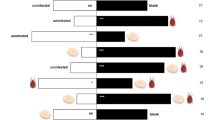Abstract
Two plant-derived allelochemicals, berberine and α-terthienyl (α- T), were tested for their effects on the European corn borer,Ostrinia nubilalis, and its endoparasitoidDiadegma terebrans. The compounds were administered to the host insect in meridic diets, and the responses of the host larvae and parasitoids reared from treated hosts were measured in terms of growth parameters and survival. InO. nubilalis, survival to pupation and adult emergence were reduced significantly by the inclusion of berberine and α-T in larval diets at a concentration of 100 μg/g. However, in the parasitoid, adverse effects were much more apparent with the α-T treatment than with the berberine treatment. α-T and one of its metabolites were found in host larvae and in emerged adult parasitoids and their cocoons. Berberine residues were not detected. The implications of these responses to compounds of widely differing physiological properties are discussed with reference to host-plant resistance and biological control.
Similar content being viewed by others
References
Barbosa, P., Saunders, J.A., andWaldvogel, M. 1982. Plant-mediated variation in herbivore suitability and parasitoid fitness, pp. 63–71,in Proceedings, 5th Symposium Insect-Plant Relationships, Wageningen. Pudoc, Wageningen.
Barbosa, P., Saunders, J.A., Kemper, J., Trumbule, R., Olechno, J., andMartinat, P. 1986. Plant allelochemicals and insect parasitoids: Effects of nicotine onCotesia congregata (Say) (Hymenoptera: Braconidae) andHyposoter annulipes (Cresson) (Hymenoptera: Ichneumonidae).J. Chem. Ecol. 12:1319–1328.
Benn, M., Degrave, J., Gnanasunderam, C., andHutchins, R. 1979. Host-plant pyrrolizidine alkaloids inNyctemera annulata Boisduval: Their presistence through the life-cycle and transfer to a parasite.Experientia 35:731–732.
Bodor, N., Farag, H.H., andBrewster, M.E., III. 1981. Site-specific, sustained release of drugs to the brain.Science 214:1370–1372.
Bohlmann, F., Burkhardt, T., andZdero, C. 1973. Naturally Occurring Acetylenes. Academic Press, London. 547 pp.
Caffrey, D.J., andWorthley, L.H. 1927. A progress report on the investigations of the European corn borer. U.S.D.A. Bull. 1476. pp. 1–155.
Campbell, B.C., andDuffey, S.S. 1979. Tomatine and parasitic wasps: Potential incompatibility of plant antibiosis with biological control.Science 205:700–702.
Campbell, B.C., andDuffy, S.S. 1981. Alleviation of α-tomatine-induced toxicity to the parasitoid,Hyposoter exiguae, by phytosterols in the diet of the host,Heliothis zea.J. Chem. Ecol. 7:927–945.
Champagne, D.E., Arnason, J.T., Philogene, B.J.R., Morand, P. andLam, J. 1986. Lightmediated allelochemical effects of naturally occurring polyacetylenes and thiophenes from Asteraceae on herbivorous insects.J. Chem. Ecol. 12:835–858.
Downum, K.R., Keil, D.J., andRodriguez, E. 1985. Distribution of acetylenic thiophenes in the Pectinidae.Biochem. Syst. Ecol. 13:109–113.
Duffey, S.S., Bloem, K.A., andCampbell, B.C. 1986. Consequences of sequestration of plant natural products in plant-insect-parasitoid interactions, pp. 31–60in D.J. Boethel and R.D. Eikenbary (eds.). Interactions of Plant Resistance and Parasitoids and Predators of Insects. Ellis Horwood, Chichester, U.K. 224 pp.
Guthrie, W.D.,Russell, W.A., andJennings, C.W. 1971. Resistance of maize to second-brood European corn borers, p. 165–179,in Proceedings, 26th Annual Corn Sorghum Research Conference. Chicago.
Hodgson, B.E. 1928. The host plants of the European corn borer in New England. U.S.D.A. Tech. Bull. 77. pp. 1–20.
McLachlan, D. 1984. Mechanism of action of polyacetylene and thiophene photosensitization. MSc thesis. University of Ottawa, Ottawa, Canada. 144 pp.
Rothschild, M., Valadon, G., andMummery, R. 1977. Carotenoids of the pupae of the large white butterfly (Pieris brassicae) and the small white butterfly (Pieris rapae).J. Zool. London 181:323–339.
Stuffness, M., andCordell, G.A. 1985. Antitumor alkaloids, pp. 188–198,in A. Brossi, (ed.). The Alkaloids: Chemistry and Pharmacology, Vol. 25. Academic Press, Orlando, Florida. 369 pp.
Thurston, R., andFox, P.M. 1972. Inhibition by nicotine ofApanteles congregatus from its host, the tobacco hornworm.Ann. Entomol. Soc. Am. 65.
Author information
Authors and Affiliations
Rights and permissions
About this article
Cite this article
McDougall, C., Philogène, B.J.R., Arnason, J.T. et al. Comparative effects of two plant secondary metabolites on host-parasitoid association. J Chem Ecol 14, 1239–1252 (1988). https://doi.org/10.1007/BF01019349
Received:
Accepted:
Issue Date:
DOI: https://doi.org/10.1007/BF01019349




